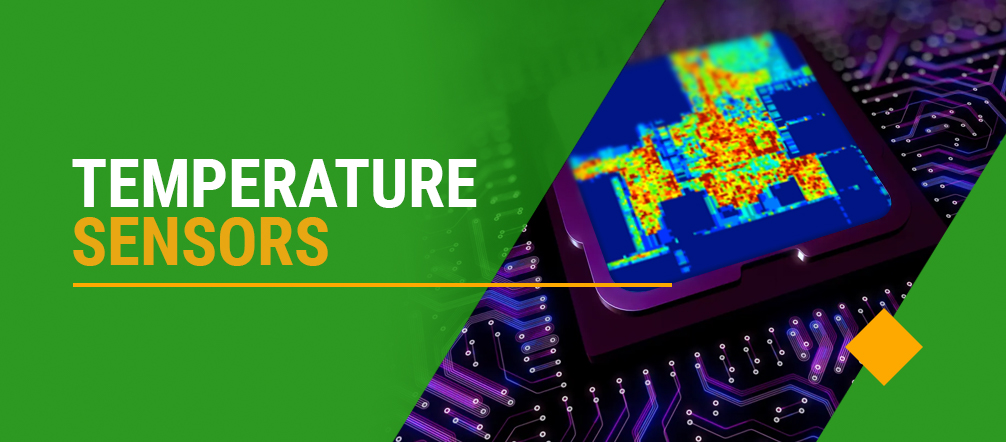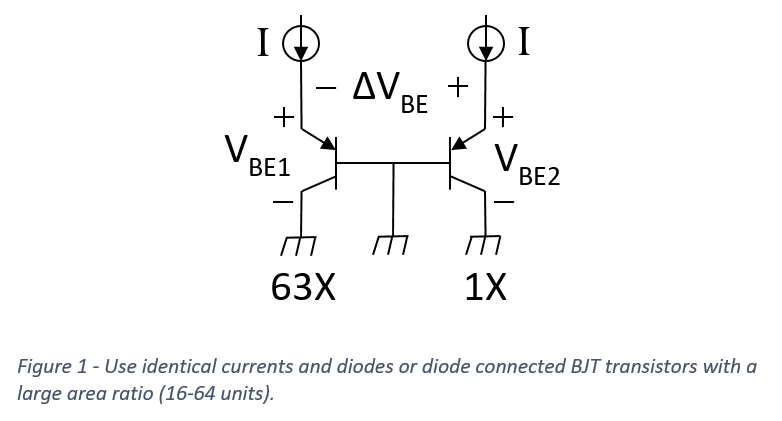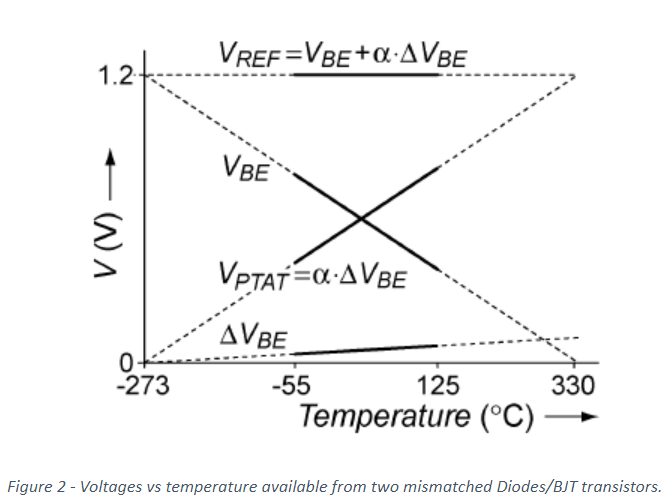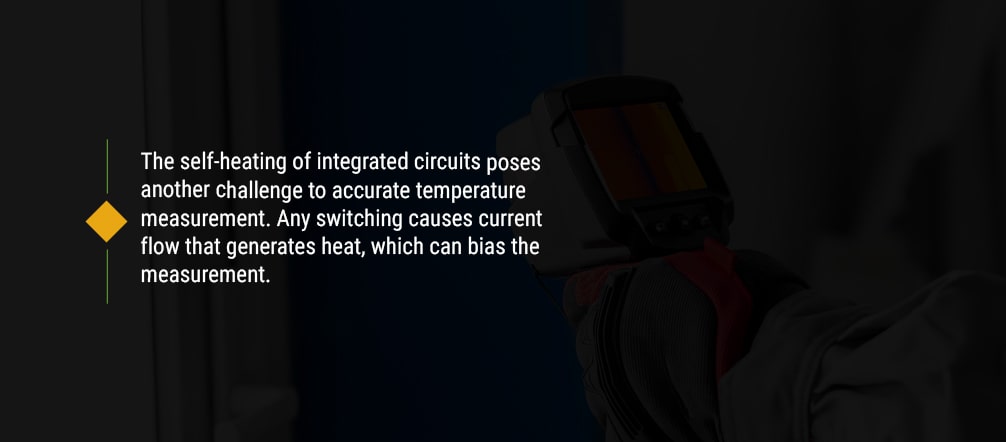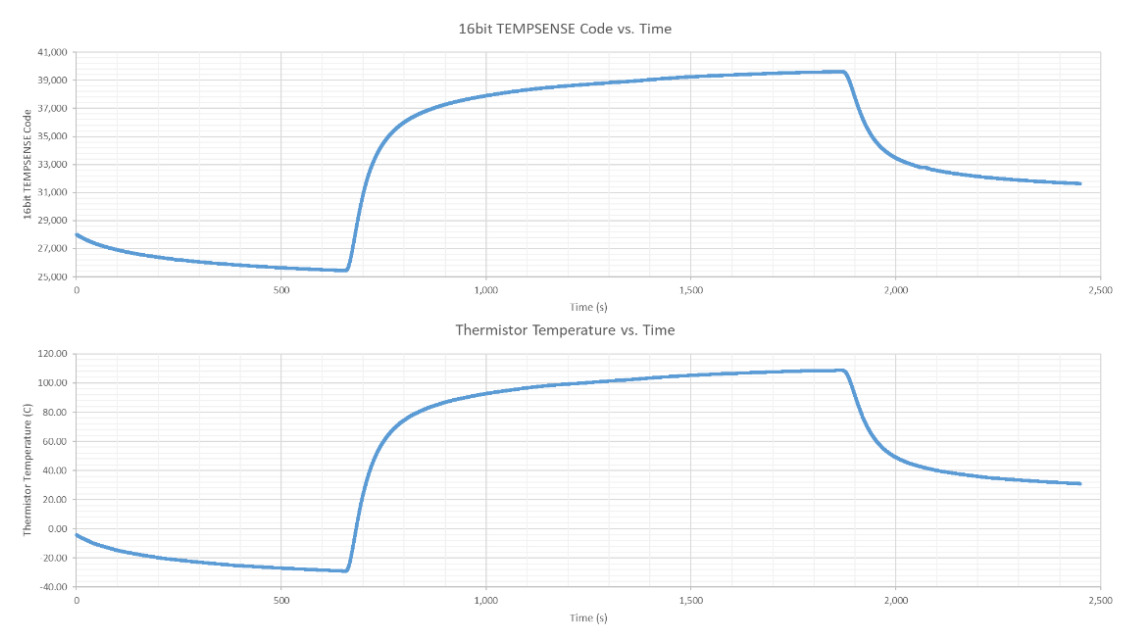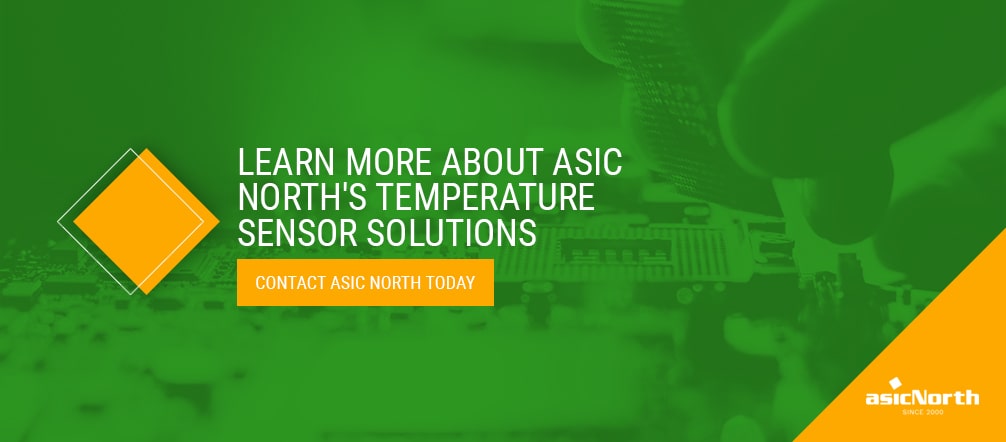Jump to:
- Embedded Temperature Sensor Applications for ASICS
- Techniques for Measuring Temperature
- Design Considerations for a Temperature Sensing Circuit
- How Calibration Affects Temperature Sensing
- Learn More About ASIC North’s Embedded Temperature Sensor Solutions
Temperature Sensors for ASICs
Today’s electronics devices interface more than ever with the real world through various sensors. A key factor in the performance of integrated circuits is temperature, whether that be the temperature of the environment or the temperature of the silicon. As a result, IC designs must be capable of monitoring temperature; however, temperature sensing circuitry has complexities that cannot be trivialized.
One strategy is to embed the temperature sensor as part of a semiconductor chip (ASIC). These sensors generate electrical signals, like voltage or current, in response to temperature and/or temperature changes and convert the electrical signals into numbers that the ASIC can utilize for feedback.
A system’s operation hinges on the accuracy of an embedded temperature sensor‘s measurements. Therefore, choosing the correct integrated temperature sensor IP for your device is critical to your successful hardware designs.
Embedded Temperature Sensor Applications for ASICs
Temperature sensors are key IP elements that are required in a variety of applications. Some common uses for temperature sensor IP include:
- Power Management: Data centers and calibration labs generate high amounts of heat during normal operation. Incorporating embedded temperature sensors prevents overheating that can damage machines.
- Clock speed optimization: Accurate temperature sensors for semiconductors can keep CPU systems within their thermal design limits and prevent under-clocking and thermal throttling, thus optimizing the device’s overall performance.
- Integrated circuits: Embedded temperature sensors for ICs sense and respond to changes in system temperature, keeping power-hungry ICs within a safe working temperature range.
Techniques for Measuring Temperature
ASIC applications often need to determine how to measure temperature. It is easy to measure temperature. It is difficult to measure it accurately. Some applications require both high precision and high accuracy. These design constraints drive certain architecture choices.
Most silicon-based temperature sensors are based on substrate PNP transistors, which have highly linear responses to temperature over a wide range. By using a pair of transistors with different current densities, the associated voltage difference is directly related to the temperature. By construction, the absolute voltage and current cancel out, and a linear representation of temperature remains. However, the rate of change of this difference is relatively small — roughly 200uV per degree Celsius.
Additionally, in a fully integrated system, diode voltages will need to be compared with a voltage reference. It is common to use a bandgap as a reference, but an untrimmed bandgap will typically be the major factor in reduced absolute accuracy.
State-of-the-art temperature sensors, as documented by Pertijs, Makinwa, and Huijsing in their IEEE Journal of Solid-State Circuits paper “A CMOS Smart Temperature Sensor With a 3 Sigma Inaccuracy of +/- 0.1°C From -55°C to 125°C,” take advantage of both VBE and ∆VBE because these components track linearly with temperature over a broad thermal range.
The challenge is calibrating out bandgap curvature, variation of diode VBE and converter gain variation. However, even combined VBE and ∆VBE sensors only have a ~2mV/C slope. A high-resolution data converter is needed for high-temperature resolution, which can be achieved using a sigma-delta converter. A sigma-delta converter type is well-matched to temperature sensor applications because they have very high resolution, and their relatively low bandwidth is not usually an issue.
Design Considerations for a Temperature Sensing Circuit
The right architecture is a good start, but implementation is everything when it comes to designing a temperature sensing circuit.
- A stable voltage reference across the entire target range is also necessary for accurate measurements. It is recommended that a bandgap circuit with curvature correction be used for this temperature sensing application.
- The self-heating of integrated circuits poses another challenge to accurate temperature measurement. Any switching will cause current flow that will generate heat that could bias the measurement. Careful consideration must be made to settle the system and sample the temperature at the right time to minimize the potentially disastrous impact of self-heating. Algorithms that return to a consistent default state help to minimize sensor self-heating.
- For the most precise measurements, there’s another challenge — 1/f noise, which is a type of low-frequency noise that decreases at higher frequencies. Trapped, quantized charges and random manufacturing defects are common sources of this type of noise.
1/f noise can significantly bias temperature measurements and might be characterized as drift at very low frequencies. Here are some techniques to manage 1/f noise:
- Offset canceling
- Dynamic element matching
- Chopping
- Increasing circuit area
- Duty cycling, also known as power downtime
How Calibration Affects Temperature Sensing
Without calibration, temperature sensors are going to exhibit part-to-part variation, which can negatively impact your application. Thankfully, calibration is a simple way to remove part to part variation. You can do this in one of two ways — many-point calibration or single-point calibration.
Many-point calibration requires measuring every part at many temperatures and creating a look-up table to convert those measurements to the correct temperature. Many-point calibration is often not practical because of the time and ultimately the cost of such a solution.
However, most of the improvements in the accuracy of many-point calibration can be accomplished with a single-point calibration done at the wafer or product level. A single-point temperature measurement is where the reference, diode voltages and data converter result are collectively used to select calibration coefficients that are not just useful at that single temperature but help to increase accuracy across the entire temperature range.
Learn More About ASIC North’s Embedded Temperature Sensor Solutions
In summary, temperature sensors are key IP elements that are required in a variety of applications.
At ASIC North, our temperature sensors utilize an architecture that combines many of the most advanced techniques, including integrated bandgap reference, chopped unit current sources, precise switch cap analog circuits, finite gain compensated integrators, high-resolution sigma-delta ADC, and single point calibration schemes. Our silicon-proven embedded temperature sensor solutions are available in configurations of 180, 130, and 45nm.
Having a partner with a wide range of IP experience, including temperature sensors, assures you of a first pass success. Contact us today to learn more about how ASIC North can assist with your temperature measurement solutions.


